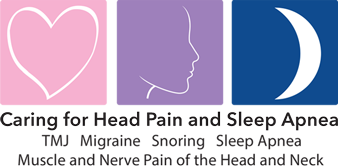
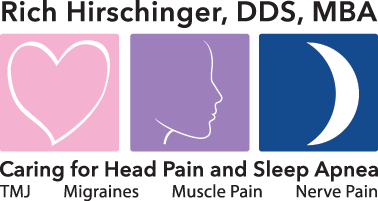
Diplomate American Board of Orofacial Pain
9615 Brighton Way, Suite 323
Beverly Hills, CA 90210
888.981.8981
Botox Treatment for Chronic Migraine
Humans have many neurotransmitters in their body. Some control our mood, some control our sleep, some control pain, and some control muscle contractions. Botox can interfere with the transmission of some of these neurotransmitters. One of them is called acetylcholine, which is responsible for muscle contraction. Acetylcholine is released from the end of a muscle spindle, attaches to another muscle spindle, and a contraction occurs. Botox prevents the release of acetylcholine, which reduces the muscles ability to contract. Researchers believe that when the is injected into the muscles it interferes with the transmission of various signals that get sent to the brain, which results in a reduction and potential elimination of chronic migraines.
Why Botox for Chronic Migraine?
Botox is an option that we have to treat chronic migraine. It it not usually a first line treatment due to the cost of the treatment and the effectiveness of the treatment. Some patients do not like to take systemic (pills) medications and others use Botox since other treatment options did not help. Unfortunately with migraine, there is not one single treatment option that works for everyone. Treating migraine consists of "trying this, then that, then maybe this and that."
Botox Injection Sites
The FDA protocol for using Botox for chronic migraine involves injecting 31 sites with 5 units of Botox. Of those, 15 sites are on the front and side of the head, and 16 sites are in the back of the head, and shoulder muscles.
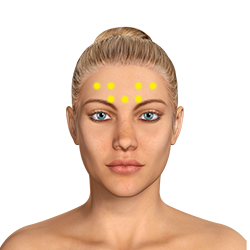 |
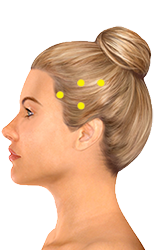 |
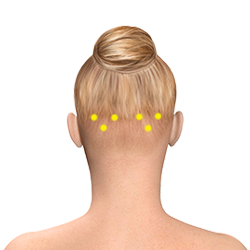 |
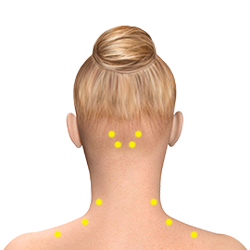 |
| Procerus, Corrugators, and Frontalis | Temporalis | Occipitalis | Cervical Paraspinal, and Trapezius |
Muscles Injected on the Front of the Head
Procerus and Corrugators: Procerus is a single muscle in the middle of the eyebrows, and the corrugators are the muscle lateral to the procerus, so there is one on each side. These are the three lower dots in the image on the far left. Combined, they cause the "11" lines, which appear when you make an angry face, which lowers the eyebrow.
Frontalis: This is the muscle that extends the length of the forehead. These are the four upper dots in the image on the far left. They appear when you raise your eyebrows, which is a "surprise face."
Muscles Injected on the Side of the Head
Temporalis: The temporalis is one of the four muscles that closes the jaw, and is involved in chewing, clenching, and grinding. These are the dots in the image second from the left.
Muscles Injected on the Back of the Head
Occipitalis: This muscle is very thin, and it covers part of the back of the skull. Its function is to move the scalp back. These are the dots in the image third from the left.
Cervical Paraspinal: This muscle group is made up of several muscles, which include the splenius capitis, trapezius, and cervicis. This group of muscles helps support the neck, including extension of the head. These are the upper four dots in the image on the far right.
Trapezius: Its main function is to stabilize and move the scapula. In simple terms, the trapezius is the main muscle involved when shrugging your shoulders. These are the six lower dots in the image on the far right.
Learn about the muscle referral patterns of the jaw closing muscles.
Learn about the muscle referral patterns of the muscles that refer pain into the TMJ.
Learn about Botox treatment for TMJ and TMD.






